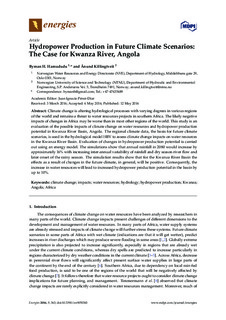| dc.contributor.author | Hamududu, Byman Hikanyona | |
| dc.contributor.author | Killingtveit, Ånund | |
| dc.date.accessioned | 2017-12-15T15:13:14Z | |
| dc.date.available | 2017-12-15T15:13:14Z | |
| dc.date.created | 2016-06-10T21:07:26Z | |
| dc.date.issued | 2016 | |
| dc.identifier.citation | Energies. 2016, 9 (5), 363. | nb_NO |
| dc.identifier.issn | 1996-1073 | |
| dc.identifier.uri | http://hdl.handle.net/11250/2472246 | |
| dc.description.abstract | Climate change is altering hydrological processes with varying degrees in various regions of the world and remains a threat to water resources projects in southern Africa. The likely negative impacts of changes in Africa may be worse than in most other regions of the world. This study is an evaluation of the possible impacts of climate change on water resources and hydropower production potential in Kwanza River Basin, Angola. The regional climate data, the basis for future climate scenarios, is used in the hydrological model HBV to assess climate change impacts on water resources in the Kwanza River Basin. Evaluation of changes in hydropower production potential is carried out using an energy model. The simulations show that annual rainfall in 2080 would increase by approximately 16% with increasing inter-annual variability of rainfall and dry season river flow and later onset of the rainy season. The simulation results show that for the Kwanza River Basin the effects as a result of changes in the future climate, in general, will be positive. Consequently, the increase in water resources will lead to increased hydropower production potential in the basin by up to 10%. | nb_NO |
| dc.language.iso | eng | nb_NO |
| dc.publisher | MDPI | nb_NO |
| dc.relation.uri | http://www.mdpi.com/1996-1073/9/5/363 | |
| dc.rights | Navngivelse 4.0 Internasjonal | * |
| dc.rights.uri | http://creativecommons.org/licenses/by/4.0/deed.no | * |
| dc.subject | Hydropower | nb_NO |
| dc.subject | Kwanza river | nb_NO |
| dc.subject | Angola | nb_NO |
| dc.subject | Climate change | nb_NO |
| dc.subject | Klimaendringer | nb_NO |
| dc.title | Hydropower Production in Future Climate Scenarios: The Case for Kwanza River, Angola | nb_NO |
| dc.type | Journal article | nb_NO |
| dc.type | Peer reviewed | nb_NO |
| dc.description.version | publishedVersion | nb_NO |
| dc.subject.nsi | VDP::Elektrotekniske fag: 540 | nb_NO |
| dc.subject.nsi | VDP::Electro-technical sciences: 540 | nb_NO |
| dc.source.pagenumber | 13 | nb_NO |
| dc.source.volume | 9 | nb_NO |
| dc.source.journal | Energies | nb_NO |
| dc.source.issue | 5 | nb_NO |
| dc.identifier.doi | 10.3390/en9050363 | |
| dc.identifier.cristin | 1360896 | |
| dc.relation.project | Norges forskningsråd: 193818 | nb_NO |
| dc.description.localcode | © 2016 by the authors; licensee MDPI, Basel, Switzerland. This article is an open access article distributed under the terms and conditions of the Creative Commons Attribution (CC-BY) license (http://creativecommons.org/licenses/by/4.0/). | nb_NO |
| cristin.unitcode | 194,64,91,0 | |
| cristin.unitname | Institutt for bygg- og miljøteknikk | |
| cristin.ispublished | true | |
| cristin.fulltext | original | |
| cristin.qualitycode | 1 | |

